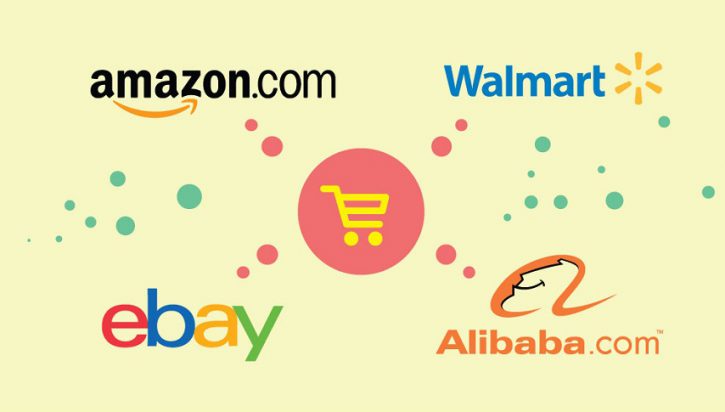
Case Study : Logo Design Inspirations for Giant eCommerce Companies
As should be expected, competition online today is as strong as it’s ever been, especially for eCommerce websites. Over the past 5 years, the number of buyers browsing for items online has increased exponentially and much like in the face-to-face retail market, big businesses have started to dominate.
The opportunities that may have been available over the past few years are not necessarily available today. So it makes sense that business owners are now more avidly looking for ways to find a competitive advantage online.
Brand identity is as important a part of this process and having a recognisable logo can both help you attract new business and maintain a strong client base. In the online world, your customer’s interaction with your business is almost completely visual, so design aspects of all kinds become very important.
How does colour impact mood in websites?
The psychology of colour is something that website managers need to take seriously. Generally, the colours of the logo will determine the colour scheme of the website; unless it’s designed in a very specific way, a website can feel a bit awkward and possibly distracting if this is not the case.
Studies suggest between 60-90% of online shoppers form some kind of a judgement about a brand exclusively based on the colour.
Let’s take a look at some of the most popular colour options for websites and what they express.
Red can be an attention-grabbing colour and can draw out strong, intense emotions and passions. It is best used carefully as it can visually and perhaps even mentally overwhelm website visitors unless it is balanced with other colours.
White is present in nearly all websites and it can be used to give visitors a feeling of space and freedom. The experience of visiting a website where white is not used can be restricting and uncomfortable as there is nothing providing clarity. It is also the ideal background colour for text.
Blue promotes feelings of trust and productivity. It’s particularly effective when used in the logos and colour schemes for companies that are business or money-orientated. The logo and website of Indian eCommerce giant Flipkart is a good example, where shades of blue above a yellow texture are predominately and vibrantly use.
Green can also represent money, but nowadays it is more readily associated with nature and the environment. It can also promote feelings of harmony and relaxation. TREEHOUSE is an online technology school that has a logo which utilises green to give an aura of ever-evolving fresh knowledge and this also may help customers see them in a certain positive light.
Black is another colour that can be very effective in eCommerce if utilised properly. Black is a popular colour for fashion websites like ASOS (used more particularly for men’s clothing stores), black exudes strength and power. But again overdoing it can have the opposite effect and even promote something of a negative sentiment.
Yellow, unsurprisingly, is a bright, playful and lively colour that can be used to draw the potential customer’s attention to certain places on the website. Again, because it has such a strong aura and identity, it needs to be used with subtly in most cases. Well, look at SnapChat, right?
What do you want your logo to say about your business?
The above colour outlines provide you with a starting point from which to make decisions about your logo and website. But it is naturally difficult to make generalisations about how people feel when they see certain colours, and there are naturally always exceptions to the rules.
For instance, under the right circumstances, a predominately yellow colour scheme may work perfectly well on a website for those who are looking to tap into that bright, happy sentiment.
That said, when you’re starting out, your best bet is to stick with what works in the majority of cases. Think about the subject matter of your business and the kind of brand you want to be. Are you fun and laid back? Serious and professional? Often it depends entirely on the product you’re selling.
To tap into this further, let’s take a look at some of the world’s most widely recognised eCommerce company logos and think about what they communicate to the audience.
eBay
Ebay’s logo has just recently been changed, but looking at the previous logo tells us something about the company’s evolution. Using the same bright, attention-grabbing colours, each letter in the original logo was different in terms of the level of alignment.
This made for a more wacky and goofy design than the current logo. It seemed to represent something of the wide range of weird and wonderful products available on the site and the fact that it wasn’t super professional.
While there has been some criticism that the latest logo is too similar to Google’s, it looks to express this sentiment in a more modern, focused and conservative way.
Amazon
Amazon is a comparable brand that offers a similar (although not identical) service. Despite this, the logo is very different in the colours used and also the sentiment.
As discussed, black in this context is powerful and visceral, while the splash of orange comes across as playful and light-hearted, meaning overall the logo remains balanced. The orange arrow also communicates the fact that you can get just about anything on Amazon.
Alibaba
Despite the fierce competition that Alibaba is giving or looking forward to giving to the market giants like Amazon and eBay, it has a logo that might give a budget-fitting, intern-designed vibe.
Apparently, the predictable and dull looking logo has far-reaching implications as the logo embeds a facial silhouette of a smiling contented customer which has also taken a creative form of a lowercase “a”, the initial of Alibaba. The orange texture of the logo is designed to represent the same confident creative approach towards brand presentation.
Walmart
This is also the case with Walmart, who is famous for its brand logo renovation. Since its launch in the year of 1962, it has introduced new brand recognition six times as of 2016.
The new logo which was adopted in 2008 has seen the company take a familiar stride, giving the logo a lighter shade of Tranquil Blue/Azure hue and a more web and mobile responsive font but keeping close enough to the last iteration to be easily identified.
The intended approach to the choice of the logo colour is to give a sense of refreshment and according to the company, a renewed sense of purpose. Previously all-capped logo of WAL-MART has been toned down to a logo using lower case letters and the new inclusion of a yellow sun shape has given the logo a more sparkly, personalized form.
Thinking about the colour schemes and logos of famous brands helps you gain an insight into how to best tackle this for your own business. Professionals can work with designers for months deliberating on these decisions, so don’t be concerned if you’re still a little lost.
If you are starting a new business and need some help, speak to a logo design expert today to talk about your options.
You read a lot. We like that
Want to take your online business to the next level? Get the tips and insights that matter.





